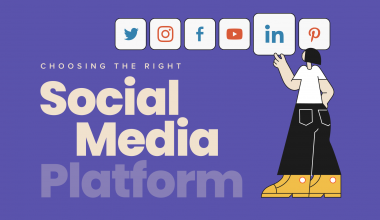Although there is a big argument about whether SEO is better than SEM, and vice versa, we think that it’ll be more logical to add Social Media into the mix. Similarly, classified as digital marketing, social media is a rising marketing strategy with a lot of potentials.
To put this from a different angle, SEM and Social Media Ads are similar in the sense that they are considered digital paid advertisements. Both strategies can be effective, but it’s important to understand the key differences before investing in either option.
What are Social Media Ads?
Social Media Ads are a tactic under the umbrella strategy of Social Media Marketing (SMM). Basically, SMM is a strategy where brands and companies utilise social media platforms to engage with their consumers, build brand awareness and promote products as well as services. There are many tactics included in the SMM strategy; normal social media posting to get organic followers and paid advertisements like Social Media Ads.
Equivalent to traditional advertising, Social Media Ads involve companies paying social media platforms to have their advertisements put right in front of their target audience. They are commonly known as “sponsored posts”. However, social media has the ability to filter, classified and target its users according to their demographics, interests and behaviours. Therefore, you can reach your ideal customers at the right place and time. For instance, if a female young adult Instagram user followed a K-pop boy group, Seventeen’s Instagram and constantly searches Korean skincare brands, she will be targeted by SOME BY MI’s Social Media Ads that showcase their new ambassador, S.COUPS (member of Seventeen) promoting their skincare line.

What is SEM?
SEM aka Search Engine Marketing is a strategy that promotes a business, services or products through paid advertisements or Pay-per-click (PPC) on search engine results pages (SERPs).
If you’re interested to learn more about SEM, check out our other blogs:
- A Helpful Beginner Guide to SEO & SEM
- How To Improve Quality Score & Win The Ad Auction
- 6 Spotlight Benefits Of SEM
Social Media Ads vs SEM
After we have compared SEO and SEM, we will now weigh up the differences between Social Media Ads and SEM. While SEO and SEM have their own similarities – both happening on search engines, SEM and Social Media Ads too have their resemblances. They are both paid advertisements that are not organic and require continuous payments.
Check out “SEO vs SEM: Which is better?”, if you’re interested to learn more.
Ad Placement
Obviously, as self-explanatory as in their names, SEM is paid advertisements located on search engines while Social Media Ads are on social media platforms. Despite having a number of search engine options to choose from such as Baidu, Bing and Yahoo, we all know that it is the tech giant, Google that dominates the industry. So, compared with Social Media Ads, SEM has lesser search engine platform options to choose from.

In the social media industry, you could choose from a variety of platforms. From discussion-based platforms like Facebook and Twitter, and visual-based platforms like Instagram and Pinterest to video platforms such as Youtube and TikTok, you have vast options to pick from according to your needs and goals. Not to mention the business-based platform LinkedIn and Chinese platforms, Red Book.

The main difference between the ad placement for SEM and Social Media Ads is that it is easier to target the ideal audience with a variety of social media platforms. Each social platform has its own specific users with distinct interests and personalities according to their demographics. Say, if you want to target Boomers, Facebook Ads is what you should go for; as for teenagers though, TikTok is your choice; and for the Chinese audience, Red Book and Douyin (the Chinese version of TikTok) are the ideal ones.
In short, social media platforms make it easier for companies to filter through a large number of users and accurately locate their ads in front of the eyes of their target audience.
Creativity
When put side by side, SEM has more limitations than Social Media Ads. If you go over to search engines for a look, you will notice that most of the ads on search engines are static. For SEM, the main focus is on the copy and images. Since it largely relies on keyword targeting, the ad copy has to be straightforward and optimized with the relevant keywords.
Thus, most of the ads on search engines are in text form like this:

Of course, there are also other forms of ads on search engines. For example, if you are promoting a product, you could go for Shopping Ads.

The above-mentioned ads are typically located on the search engine itself. However, SEM also includes other forms of ads like display ads that can be flexible in presenting images and videos. They are normally displayed on websites or in Gmail.


On the other hand, Social Media Ads allow flexibility and creativity when it comes to the form, type and placement of the ad. As it is a very visual place on these social media platforms, the ads have to be animated and eye-catching with suitable background music or voice-over.
There are various types of ads you could opt for in Social Media Ads. Depending on the kind of social media platforms you use, you could go for static image ads, carousel ads, video ads, messenger ads, stories ads, slideshow ads or collection ads. In fact, different kinds of social media platforms have different ad placements.
For instance, if you’re using Facebook, you could choose to place your ads as typical static image ads, carousel ads, collection ads or video ads on users’ feeds as well as on their messenger app.

While on Instagram, you have the option to place ads on IG Stories, Reels as well as the Explore page.

Target Consumers
Another important difference between Social Media Ads and SEM is the target consumers. This includes the way the ads attract consumers and the type of consumers it attracts.
In the case of SEM, Pay-per-click ads target consumers who are ready to buy. They are more than often located at the bottom of the funnel (BOFU) of the buying stages. It is because their proactive actions in researching search engines indicate their high purchase intentions. Put simply, your ads wouldn’t be shown to them if they didn’t search for your targetted keywords. Hence, this is also the reason why you don’t really need visually attractive ads to attract them. All they need is your quality assurance and a clear call-to-action (CTA) to nudge them into purchasing.
Contrastingly, social media is a platform to connect and build awareness as well as long-lasting relationships. Therefore, Social Media Ads aim to build brand awareness and interest in consumers instead of hard selling. They commonly target the ones located at the top of the funnel (TOFU) by introducing the brand to them. These social media users are not ready to buy your products/services yet, in fact, they may not even know your brand’s existence. Occasionally promoting your social media ads when they are scrolling on the platforms helps construct a brand image that would stick in their mind. Social Media Ads are a great way to increase exposure but use it sparingly as they can easily be deemed annoying.

Which one should you use then?
When it comes to digital marketing, we would always advise you to use both. This is because these strategies work toward different goals and together, they create an effective plan.
Nonetheless, if you have to choose one, here are some of our suggestions:
I) Use Social Media Marketing and Advertising if you are a new brand and don’t have a lot of budgets. Introduce your brand story and purpose to your audience on social media platforms through normal postings. Check out Awesome Content Ideas to Introduce Your New Brand on Instagram if you need a headstart. Then, boost your posts or create Social Media Ads to reach more users. Social Media allows you to engage with your audience on a personal level where you can reply to comments and messages.
II) Use SEM if you are an established brand or if you want to increase traffic to your website. With SEM, you have the ability to control the costs of your ads and you will only have to pay when someone clicks on them. Check out 6 Spotlight Benefits Of SEM to learn more about its advantages. Of course, you do need to have the budget and manpower that could help sustain your SEM campaigns for a period of time.
In conclusion, Social Media Ads and SEM are different in terms of the consumers they target, attract and the ad placements. They could achieve different goals that benefit your business. At the end of the day, it comes to how you strategize and plan your digital marketing plan to better suit your business.










